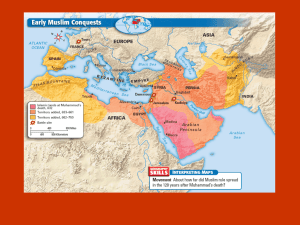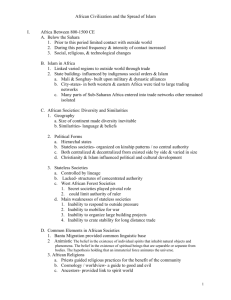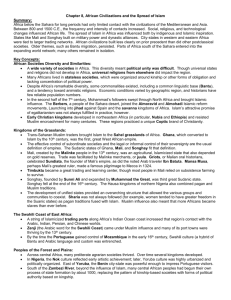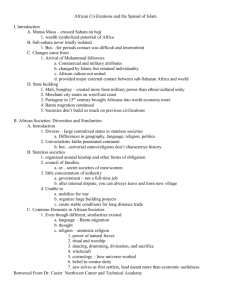African Civilizations and the Spread of Islam
advertisement
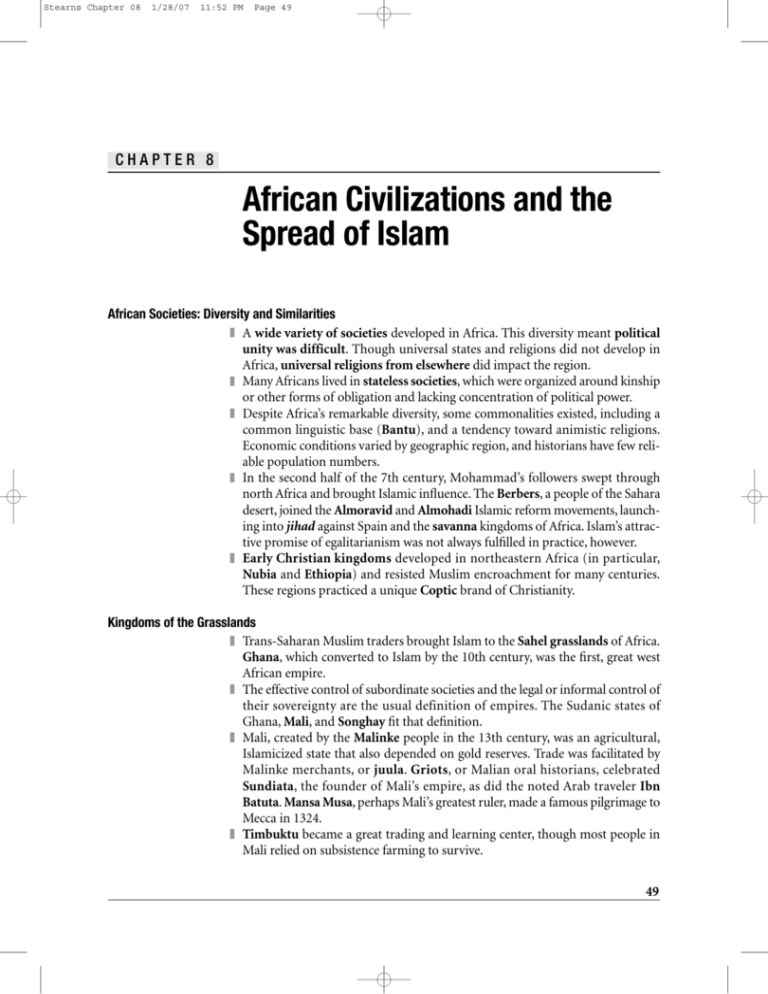
Stearns Chapter 08 1/28/07 11:52 PM Page 49 CHAPTER 8 African Civilizations and the Spread of Islam African Societies: Diversity and Similarities A wide variety of societies developed in Africa. This diversity meant political unity was difficult. Though universal states and religions did not develop in Africa, universal religions from elsewhere did impact the region. Many Africans lived in stateless societies, which were organized around kinship or other forms of obligation and lacking concentration of political power. Despite Africa’s remarkable diversity, some commonalities existed, including a common linguistic base (Bantu), and a tendency toward animistic religions. Economic conditions varied by geographic region, and historians have few reliable population numbers. In the second half of the 7th century, Mohammad’s followers swept through north Africa and brought Islamic influence. The Berbers, a people of the Sahara desert, joined the Almoravid and Almohadi Islamic reform movements, launching into jihad against Spain and the savanna kingdoms of Africa. Islam’s attractive promise of egalitarianism was not always fulfilled in practice, however. Early Christian kingdoms developed in northeastern Africa (in particular, Nubia and Ethiopia) and resisted Muslim encroachment for many centuries. These regions practiced a unique Coptic brand of Christianity. Kingdoms of the Grasslands Trans-Saharan Muslim traders brought Islam to the Sahel grasslands of Africa. Ghana, which converted to Islam by the 10th century, was the first, great west African empire. The effective control of subordinate societies and the legal or informal control of their sovereignty are the usual definition of empires. The Sudanic states of Ghana, Mali, and Songhay fit that definition. Mali, created by the Malinke people in the 13th century, was an agricultural, Islamicized state that also depended on gold reserves. Trade was facilitated by Malinke merchants, or juula. Griots, or Malian oral historians, celebrated Sundiata, the founder of Mali’s empire, as did the noted Arab traveler Ibn Batuta. Mansa Musa, perhaps Mali’s greatest ruler, made a famous pilgrimage to Mecca in 1324. Timbuktu became a great trading and learning center, though most people in Mali relied on subsistence farming to survive. 49 Stearns Chapter 08 1/28/07 11:52 PM Page 50 Songhay, founded by Sunni Ali and expanded by Muhammad the Great, was the third great Sudanic state. Songhay fell at the end of the 16th century. The Hausa kingdoms of northern Nigeria also combined pagan and Muslim traditions. The development of unified states provided an overarching structure that allowed the various groups and communities to coexist. Sharia was not always followed (for example, women tended to have greater freedom in the Sudanic states) as pagan traditions fused with Islam. Muslim influence also meant that more Africans became slaves than ever before. The Swahili Coast of East Africa A string of Islamicized trading ports along Africa’s Indian Ocean coast increased that region’s contact with the Arabic, Indian, Persian, and Chinese worlds. Zenj (the Arabic word for the Swahili Coast) came under Muslim influence and many of its port towns were thriving by the 13th century. By the time the Portuguese gained control of Mozambique in the early 16th century, Swahili culture (a hybrid of Bantu and Arabic language and customs) was entrenched. Peoples of the Forest and Plains Across central Africa, many preliterate agrarian societies thrived. Over time, several kingdoms developed. In Nigeria, the Nok culture reflected early artistic achievement; later, Yoruba culture was highly urbanized and politically organized. East of Yoruba, the Benin city-state was powerful enough to impress Portuguese visitors. South of the Zambezi River, beyond the influence of Islam, many central African peoples had begun their own process of state formation by about 1000, replacing the pattern of kinship-based societies with forms of political authority based on kingship. Along the Congo River, the state of Kongo was spread out in family-based villages and towns. There was a sharp division of labor between women and men. Another large Bantu confederation, with extensive trade connections, developed east of the Congo. Its headquarters were at Great Zimbabwe, an impressive set of stone structures. Multiple-Choice Questions 1. Unlike the Americas, sub-Saharan Africa (A) never developed a classical civilization. (B) was never totally isolated from other civilizations. (C) had little popular migration or trade. (D) developed its indigenous civilizations later. (E) had no extensive river systems or grasslands. 50 2. Sub-Saharan African societies are similar to Latin American Indian societies in that both (A) built classical civilizations without cultural diffusion from other civilizations. (B) developed in mountainous environments. (C) originated complex mathematics and scientific traditions. (D) had numerous similarities making it impossible to generalize about them. (E) were devastated by contacts with PART II: TOPICAL REVIEW WITH SAMPLE QUESTIONS AND ANSWERS AND EXPLANATIONS Stearns Chapter 08 1/28/07 11:52 PM Page 51 Europeans and Arabs, which led to mass epidemics and the death of whole indigenous populations. 7. A common concern for west African Muslim jurists and clerics was (A) the persistence of pagan beliefs and practices among its population. (B) control of the trans-Saharan trade. (C) influence of Christianity on west Africans. (D) the practice of polygamy by many African families. (E) the puritanical nature of west African society. 3. While all of these peoples migrated to, settled, and influenced north Africa, the only indigenous inhabitants seem to be the (A) Phoenicians (Carthaginians). (B) Greeks and Romans. (C) Vandals. (D) Arabs. (E) Berbers. 8. Islam was spread through west and east Africa as well as southeast Asia by (A) jihad or holy war. (B) mass conversions ordered by the rulers and monarchs. (C) wandering Sufi mystics. (D) merchants who established Muslim families and traditions. (E) migration to the areas by large groups of Muslims. 4. Islamic teachings in north and west Africa (A) served to divide the people. (B) fostered jihads and crusades between Christians and Muslims. (C) destroyed the trade between west and north African ports. (D) introduced a common bond but did not erase social or ethnic stratifications. (E) put an end to the African slave trade. 5. The first black African states and civilizations developed (A) in the Sahel, the grassland belt south of the Sahara. (B) in the tropical forests along the coasts of the Atlantic Ocean. (C) in the Ahaggar and Atlas Mountains around and in the Sahara. (D) along the coasts of east Africa. (E) in the highland plateaus of Ethiopia. 6. Islam in west Africa (A) was popular with most elements of society. (B) converted the kings and elites first without necessarily affecting the masses. (C) interested merchants alone. (D) confronted an entrenched Christian religion, which resisted conversion. (E) had little lasting effect on the area. 9. After the arrival of Islam, societies in west Africa (A) became largely patrilineal. (B) implemented Islamic law regarding the seclusion of women. (C) often continued to recognize traditions granting women extensive rights. (D) abandoned the tradition of polygamy. (E) abolished slavery. 10. The slave trade from west Africa to the Muslim world (A) was abolished once the inhabitants converted to Islam. (B) existed before the arrival of Islam but was expanded over the centuries. (C) was introduced by the Muslims. (D) rivaled the trans-Atlantic slave trade in numbers and brutality. (E) preferred male slaves for administration and military occupations. Free-Response Question In what ways did Islam influence sub-Saharan African culture? CHAPTER 8: AFRICAN CIVILIZATIONS AND THE SPREAD OF ISLAM 51 Stearns Chapter 08 1/28/07 11:52 PM Page 52 ANSWERS AND EXPLANATIONS Multiple-Choice Questions 1. (B) is correct. Though at times communication was intermittent, sub-Saharan Africa had numerous contacts with Europe, the Islamic world, and south Asia. Mansa Musa’s pilgrimage to Mecca is one famous example of such contact. 2. (D) is correct. Radically different cultures developed in the many regions of Africa, informed by geography, proximity to other cultures, and regional idiosyncrasies. 3. (E) is correct. The Berbers, who helped to spread Islam across many parts of Africa, came from the Sahara. 4. (D) is correct. Despite Islam’s egalitarian and utopian vision, in practice many local communities stayed socially stratified and ethnically divided. 5. (A) is correct. Ghana, Mali, Songhay, and the Hausa states were all located in the Sahel region of Africa. 6. (B) is correct. Islam became something of a royal cult, and even those commoners who did convert retained many of their old beliefs. 7. (A) is correct. Many Muslim leaders sought to suppress local interpretations of Islam, including the incorporation of pagan beliefs into religious rites. 8. (D) is correct. Merchants, who established religious communities around Africa, were the most successful ambassadors of Islam. 9. (C) is correct. For example, several Sudanic societies were matrilineal, and some recognized the role of women within the lines of kinship, contrary to the normal patrilineal customs inscribed in Islamic law. North African visitors were often shocked by the easy familiarity between men and women and the freedom enjoyed by women. 10. (B) is correct. Various forms of slavery and dependent labor had existed in Africa before Islam was introduced, but with the Muslim conquests of north Africa and commercial penetration to the south, slavery became a more widely diffused phenomenon, and a slave trade in Africans developed on a new scale. Free-Response Essay Sample Response In what ways did Islam influence sub-Saharan African culture? From the Sahel to the Swahili Coast, Islam has a dramatic effect on Africa. Though generalizing about African culture is difficult, it is possible to show the influence of Islam on the continent. Islam attracted rulers and regional elites, but the masses either retained old beliefs or incorporated those beliefs into local versions of Islam. Nevertheless, Muslim influence brought with it new architectural forms, increased opportunities for trade, and created a common religious bond that promoted unity among many African societies. 52 PART II: TOPICAL REVIEW WITH SAMPLE QUESTIONS AND ANSWERS AND EXPLANATIONS





